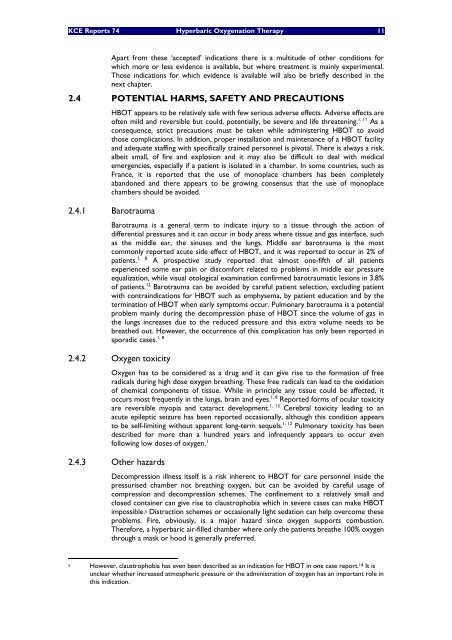Hyperbare Zuurstoftherapie: Rapid Assessment - KCE
Hyperbare Zuurstoftherapie: Rapid Assessment - KCE
Hyperbare Zuurstoftherapie: Rapid Assessment - KCE
You also want an ePaper? Increase the reach of your titles
YUMPU automatically turns print PDFs into web optimized ePapers that Google loves.
<strong>KCE</strong> Reports 74 Hyperbaric Oxygenation Therapy 11<br />
Apart from these ‘accepted’ indications there is a multitude of other conditions for<br />
which more or less evidence is available, but where treatment is mainly experimental.<br />
Those indications for which evidence is available will also be briefly described in the<br />
next chapter.<br />
2.4 POTENTIAL HARMS, SAFETY AND PRECAUTIONS<br />
HBOT appears to be relatively safe with few serious adverse effects. Adverse effects are<br />
often mild and reversible but could, potentially, be severe and life threatening. 1, 11 As a<br />
consequence, strict precautions must be taken while administering HBOT to avoid<br />
those complications. In addition, proper installation and maintenance of a HBOT facility<br />
and adequate staffing with specifically trained personnel is pivotal. There is always a risk,<br />
albeit small, of fire and explosion and it may also be difficult to deal with medical<br />
emergencies, especially if a patient is isolated in a chamber. In some countries, such as<br />
France, it is reported that the use of monoplace chambers has been completely<br />
abandoned and there appears to be growing consensus that the use of monoplace<br />
chambers should be avoided.<br />
2.4.1 Barotrauma<br />
Barotrauma is a general term to indicate injury to a tissue through the action of<br />
differential pressures and it can occur in body areas where tissue and gas interface, such<br />
as the middle ear, the sinuses and the lungs. Middle ear barotrauma is the most<br />
commonly reported acute side effect of HBOT, and it was reported to occur in 2% of<br />
patients. 1, 8 A prospective study reported that almost one-fifth of all patients<br />
experienced some ear pain or discomfort related to problems in middle ear pressure<br />
equalization, while visual otological examination confirmed barotraumatic lesions in 3.8%<br />
of patients. 12 Barotrauma can be avoided by careful patient selection, excluding patient<br />
with contraindications for HBOT such as emphysema, by patient education and by the<br />
termination of HBOT when early symptoms occur. Pulmonary barotrauma is a potential<br />
problem mainly during the decompression phase of HBOT since the volume of gas in<br />
the lungs increases due to the reduced pressure and this extra volume needs to be<br />
breathed out. However, the occurrence of this complication has only been reported in<br />
1, 8<br />
sporadic cases.<br />
2.4.2 Oxygen toxicity<br />
Oxygen has to be considered as a drug and it can give rise to the formation of free<br />
radicals during high dose oxygen breathing. These free radicals can lead to the oxidation<br />
of chemical components of tissue. While in principle any tissue could be affected, it<br />
occurs most frequently in the lungs, brain and eyes. 1, 8 Reported forms of ocular toxicity<br />
are reversible myopia and cataract development. 1, 13 Cerebral toxicity leading to an<br />
acute epileptic seizure has been reported occasionally, although this condition appears<br />
to be self-limiting without apparent long-term sequels. 1, 12 Pulmonary toxicity has been<br />
described for more than a hundred years and infrequently appears to occur even<br />
following low doses of oxygen. 1<br />
2.4.3 Other hazards<br />
Decompression illness itself is a risk inherent to HBOT for care personnel inside the<br />
pressurised chamber not breathing oxygen, but can be avoided by careful usage of<br />
compression and decompression schemes. The confinement to a relatively small and<br />
closed container can give rise to claustrophobia which in severe cases can make HBOT<br />
impossible. a Distraction schemes or occasionally light sedation can help overcome these<br />
problems. Fire, obviously, is a major hazard since oxygen supports combustion.<br />
Therefore, a hyperbaric air-filled chamber where only the patients breathe 100% oxygen<br />
through a mask or hood is generally preferred.<br />
a However, claustrophobia has even been described as an indication for HBOT in one case report. 14 It is<br />
unclear whether increased atmospheric pressure or the administration of oxygen has an important role in<br />
this indication.

















